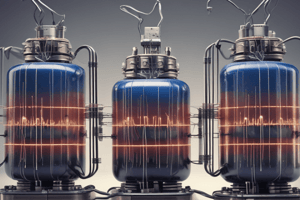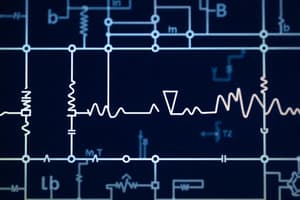Podcast
Questions and Answers
A parallel circuit has two or more paths in which current may flow.
A parallel circuit has two or more paths in which current may flow.
True (A)
In a parallel circuit, the voltage drop across each resistance is equal to the sum of the voltage drops of each of the resistors in parallel.
In a parallel circuit, the voltage drop across each resistance is equal to the sum of the voltage drops of each of the resistors in parallel.
False (B)
According to Kirchhoff's Current Law, the total current provided by the source to a parallel circuit equals the sum of the currents of all the branches.
According to Kirchhoff's Current Law, the total current provided by the source to a parallel circuit equals the sum of the currents of all the branches.
True (A)
Total power consumed in a parallel circuit equals the sum of the power of all branches.
Total power consumed in a parallel circuit equals the sum of the power of all branches.
In a parallel circuit, the total circuit resistance is always greater than the smallest resistance.
In a parallel circuit, the total circuit resistance is always greater than the smallest resistance.
The total resistance of a parallel circuit can be calculated by the ______ method.
The total resistance of a parallel circuit can be calculated by the ______ method.
According to the equal resistance method, when all the resistances of the parallel circuit have the same resistance, divide the resistance of one element by the largest resistor in parallel.
According to the equal resistance method, when all the resistances of the parallel circuit have the same resistance, divide the resistance of one element by the largest resistor in parallel.
The product over sum method is used to calculate the resistance of __________ resistances at a time.
The product over sum method is used to calculate the resistance of __________ resistances at a time.
The advantage of the reciprocal method is that the formula can be used for as many resistances as the parallel circuit contains.
The advantage of the reciprocal method is that the formula can be used for as many resistances as the parallel circuit contains.
When power supplies are connected in parallel, the voltage remains the same, but the current or amp-hour capacity will increase.
When power supplies are connected in parallel, the voltage remains the same, but the current or amp-hour capacity will increase.
Flashcards
Parallel Circuit
Parallel Circuit
A circuit with two or more paths for current flow.
Kirchhoff's Current Law
Kirchhoff's Current Law
The total current entering a junction equals the total current leaving it. The source current equals the sum of branch currents.
Power in Parallel Circuits
Power in Parallel Circuits
Total power consumed equals the sum of the power consumed by each branch.
Total Resistance in Parallel Circuits
Total Resistance in Parallel Circuits
Signup and view all the flashcards
Methods to Calculate Total Resistance
Methods to Calculate Total Resistance
Signup and view all the flashcards
Equal Resistance Method
Equal Resistance Method
Signup and view all the flashcards
Product-Over-Sum Method
Product-Over-Sum Method
Signup and view all the flashcards
Reciprocal Method
Reciprocal Method
Signup and view all the flashcards
Parallel Power Supplies
Parallel Power Supplies
Signup and view all the flashcards
Study Notes
Parallel Circuits Overview
- A parallel circuit consists of two or more pathways for electrical current to flow.
- Voltage drop across each resistor in a parallel circuit is the same for all resistors, not related to the sum of individual voltage drops.
Kirchhoff's Laws
- Kirchhoff's Current Law states that the total current from the source in a parallel circuit equals the sum of all branch currents.
Power and Resistance in Parallel Circuits
- Total power consumed in a parallel circuit is equal to the sum of power across all branches.
- Total circuit resistance in a parallel setup is always less than the smallest individual resistor, contradicting the idea that it is greater.
Calculating Resistance
- Total resistance in a parallel circuit can be calculated using various methods:
- Equal resistance method: For circuits with identical resistances, this method is not applicable by simply dividing one resistance by the largest.
- Product-over-sum method: This method is used for calculating resistance of two resistances at a time.
- Reciprocal method: This method allows for calculating the total resistance for as many resistances in parallel as present.
Power Supply Characteristics
- In parallel connections of power supplies, voltage stays constant while current or amp-hour capacity increases, enhancing energy distribution.
Studying That Suits You
Use AI to generate personalized quizzes and flashcards to suit your learning preferences.




